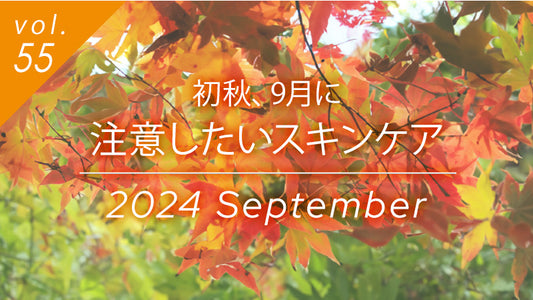
After the rainy season ended, we have been experiencing scorching hot days with maximum temperatures exceeding 35°C every day. In addition, COVID-19 has been changed to Class 5, and events such as festivals and fireworks displays are being held all over the country for the first time in four years. Although we have not overcome COVID-19, it is now treated like influenza, and it seems that more and more people are taking off their masks every day. In the old calendar, August 8th is the beginning of autumn, and in traditional Japanese letters, the writing style is to write summer greetings up to August 7th and summer greetings from August 8th onwards, but since the scorching heat seems likely to continue for a while, this division should be made more realistic. In terms of beauty, the scorching hot summer is extremely harsh. This time, I would like to introduce you to "Beauty life in the scorching hot summer".
As the scorching hot summer arrives, be careful of your skin and avoid heatstroke!
Every day, there are a lot of news reports about heat stroke. First, let's take a look at what heat stroke is.
In the past, it was called sunstroke, heatstroke, and other terms, but now it is grouped together as heatstroke. It is a disease in which body temperature rises, the balance of water and salt in the body is disrupted, and the body's thermoregulatory function stops working, causing various symptoms such as a rise in body temperature, dizziness, convulsions, and headaches. Specifically, the combination of a high temperature and high humidity environment can cause symptoms such as dizziness, excessive sweating, headaches, discomfort, nausea, vomiting, fatigue, and collapse. In severe cases, the condition can lead to loss of consciousness, convulsions, impaired movement of the limbs, and hyperthermia, putting the body at risk of death.

What the extreme heat does to your skin
Even if you don't have any symptoms of heat stroke, a hot environment can have a negative effect on your skin. You could even call it heat stroke of the skin.
- Dryness due to loss of moisture from the skin through sweating - Nutrient deficiency due to the loss of vitamins and minerals through sweating - Skin dirt caused by sweating - Poor metabolism due to temperature differences between hot weather and the cold of air conditioning - Photoaging caused by direct sunlight If these conditions are left untreated, the skin will suffer from summer fatigue, which will not only contribute to skin problems such as dullness, spots, rough skin, wrinkles, and sagging, but will also accelerate skin aging.
Measures against heatstroke and summer fatigue on the skin
Measures to prevent heatstroke are also effective for your skin.
Let's live our skin care life by keeping the following measures in mind.
- As a countermeasure against sweating, since sweating plays an important role in regulating body temperature, instead of trying to prevent it, think of sweating as a positive thing, and after sweating, make sure that the body temperature on the surface of your skin has dropped, and then wipe off the sweat or wash it off with a face wash or shower.
・ It is necessary to take measures against temperature differences. When outdoors, be aware of avoiding heat and sunlight. When indoors, take measures against the cold by wearing a jacket.
- Please consider using a hat or parasol as a measure against direct sunlight.
Vitamins and minerals are nutrients that are lost through sweat and tend to become deficient.
What are vitamins and minerals as nutrients?
Vitamins and minerals are one of the five major nutrients (protein, carbohydrates (sugar), lipids, vitamins, and minerals). Both vitamins and minerals are coenzyme-like nutrients that cannot be produced by the body and must be taken from outside. Although they can be supplemented with supplements, the basic approach is to take them through your diet.
Vitamin Basics
There are 13 types of vitamins in total: 9 water-soluble vitamins and 4 fat-soluble vitamins. While the other vitamins are individual, only the B vitamins are expressed as a group. This is because they were discovered as a single vitamin, and then research progressed on them as a mixture of multiple vitamins.
In the past, there were many vitamin-like substances that were studied as vitamins, but currently, only 13 types are classified as vitamins. Of these, we will explain about vitamins A/C/E and the B group, which are closely related to beauty.
1. Vitamin A
Also known as retinol, it is one of the "antioxidant vitamins" that promotes growth and maintains health.
② Vitamin C
It is a representative beauty vitamin. Not only does it support collagen production, but it also suppresses melanin production, making vitamin C derivatives famous as a whitening ingredient in cosmetics.
3. Vitamin E
Also known as tocopherol, it is one of the antioxidant vitamins that prevents the oxidation of lipids in the body.
Vitamins A, C, and E are the three major antioxidant vitamins and are sometimes collectively known as vitamins ACE (ace).
④ Vitamin B group There are many types of vitamins, such as vitamin B1, B2, B6, etc., and they are collectively called vitamin B group. In addition to helping maintain the health of the skin and mucous membranes, each vitamin has the following unique functions:
Vitamin B1: Relieves fatigue Vitamin B2: Maintains metabolism Vitamin B6: Prevents dermatitis and stomatitis
Basic knowledge of minerals
It is said that there are about 100 types of minerals, but the 16 types that are necessary for the human body are called "essential minerals." Specifically, these 16 types are calcium, phosphorus, potassium, sulfur, chlorine, sodium, magnesium, iron, zinc, copper, manganese, chromium, iodine, selenium, molybdenum, and cobalt.
These 16 essential minerals are classified into major and trace minerals, depending on the amounts needed.
There are seven major minerals: calcium, phosphorus, potassium, sulfur, chlorine, sodium, and magnesium, and nine trace minerals: iron, zinc, copper, manganese, chromium, iodine, selenium, molybdenum, and cobalt.
Essential minerals are nutrients that are indispensable for maintaining and forming our bodies, even though only small amounts are required, for the formation of bones and teeth, protein production, and promotion of metabolism.
From a beauty perspective, it is important to consume zinc, calcium, magnesium, copper, iron, potassium, and manganese in a balanced manner.
Both vitamins and minerals are nutrients that must be taken in from outside, and as they tend to become deficient during this time of year due to being excreted through sweating, it is important to consciously replenish them for beauty reasons.
We have brought you "The scorching hot summer is here! Skin care tips to prevent heat stroke and summer fatigue"! The next topic will be "Skin care for early autumn".



